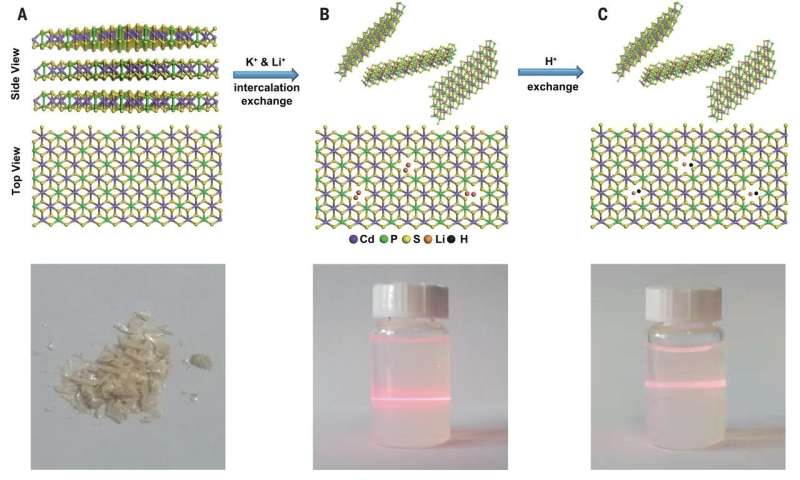October 30, 2020 report
Proton membranes assembled from 2-D layered phosphorus nanosheets

A team of researchers affiliated with a host of institutions in China has developed a new class of proton-exchange membranes (PEMs) assembled from transition-metal phosphorus trichalcogenide nanosheets. In their paper published in the journal Science, the group describes using metal vacancies to improve conductivity in the PEMs. Fengmei Wang and Jun He with the National Center for Nanoscience and Technology, Beijing have published a Perspective piece in the same journal issue outlining the history of proton exchange membrane research and the work done by the team in this new effort.
PEMs are semipermeable membranes that are most often made using ionomers. They are produced as a means for conducting protons while acting as both an electronic insulator and a reactant barrier. Typical applications include fuel cells, chemical filters and sensors. One of their drawbacks is that they lose their conductivity at high temperatures and low humidity. In this new effort, the researchers have developed a new class of PEMs that overcomes these limitations to some extent.
Currently, most functional PEMs are made from polymers or from materials that have been embedded in a polymer matrix. The current standard is the Nafion PEM. It is made using a sulfonated tetrafluoroethylene-based fluoropolymercopolymer. Like other PEMs it does its work via channels that have been optimized for transferring protons, and like other PEMs, pores must be introduced to carry out hydration. The researchers with this new effort have improved upon this design by starting with CdPS3, a layered inorganic material. They then removed small amounts of cadmium to create vacancies which resulted in increasing conductivity of the protons. Testing of the new design showed it to have proton conductivity of approximately 0.95 S/cm when in a 90°C and 98% RH environment. The researchers note that the process also works for manganese-based membranes—they tested this secondary approach and found it successfully transported lithium ions.
The researchers note that their approach allows for the creation of PEMs that are not only more efficient than those currently in use, but also allow for the creation of PEM-based products that can be used in higher temperature (up to 90 degrees Celsius) and lower humidity applications (down to 53% RH).
More information: Xitang Qian et al. CdPS3 nanosheets-based membrane with high proton conductivity enabled by Cd vacancies, Science (2020). DOI: 10.1126/science.abb9704
Journal information: Science
© 2020 Science X Network




















